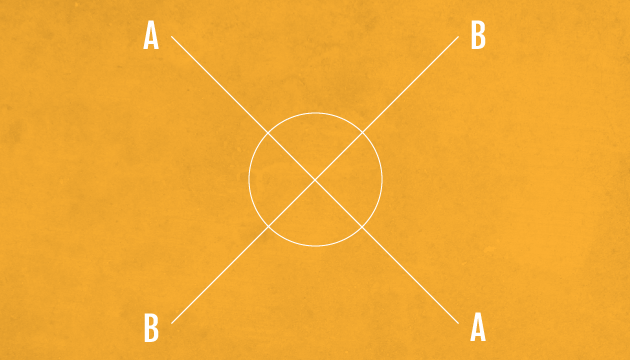In order to appreciate the Joseph story as the masterpiece that it is we must introduce you to a concept with which most of you probably are not familiar. Ancient writers and rhetoricians loved to use a literary structure that in modernity has come to be called the “chiasm,” referring to the Greek letter “chi” (our letter X). A chiastic figure of speech is a type of correspondence like the parallel structure that we have introduced, but it is inverted in its pattern. We will begin by illustrating a chiasm and then discussing why a biblical author would deploy such a pattern in writing his account.
A simple chiastic couplet is found in the Lord’s teaching on the Sabbath, found in Mark 2:27:
“The Sabbath was made for man, and not man for the Sabbath”
This simple chiasm is constituted of an a b b′ a′ sequence, when “Sabbath” is “a” and “man” is “b.” Such patterns express an inversion or a reversal. Now we should ask why the Lord would use a chiastic structure of reversal to express His teaching about the Sabbath. In the context in Mark, Jesus is confronting the tradition of the Pharisees, which taught that the law of the Sabbath was paramount over the necessities of mankind, so that a hungry man could not harvest grain on a Sabbath (Mark 2:23-24), nor could a sick man seek healing on a Sabbath (Mark 3:1-4). Jesus wants to turn the understanding of the Pharisees inside out. He wants to teach them that the Sabbath was intended to be a servant to bless man, and not to be his master. And so to teach this new way of thinking about the Sabbath, Jesus phrases His doctrine with a chiastically inverted structure.
Similarly, a major theme of Jesus’ understanding of the last judgment is the reversal of expectations that will be made manifest on that great day. For example, the Lord says in the Olivet discourse, speaking about the last judgment as recorded in Matthew 23:12: “He who exalts himself will be humbled; and he who humbles himself will be exalted.” Once again the a b b′ a′ inverted structure mimics the reversal Christ speaks of in the judgment to come, just as it does once again when Jesus speaks of the reversal of the last judgment in Matt 20:16: “So the last will be first and the first will be last.” Moreover, the chiastic structure works equally well as a figure to show reversals in mercy as well as judgment. Paul’s statement in 2 Corinthians 8:9 describes a chiastic reversal, when Christ’s blessedness prior to the incarnation is read as a temporal clause: “Though He (Christ) was rich, yet for our sakes He became poor, that we through His poverty might be made rich.” The Roman rhetoricians called the chiastic figure decussata oratio, meaning to divide cross-wise. In other words, the figure itself created a conceptual cross (X), the emblem of the place where Christ, though he was rich, became poor so that we could exchange our poverty for His riches. The inversion is thus an emblem of the exchange is proclaims, the structure mimicking the substance of the teaching.
The chiastic structures we have thus far displayed for illustration are all quite short. But the chiastic figure of speech is capable of describing longer passages of Scripture as well. For example, Judah’s climactic plea to his father Jacob displays a chiastic structure that covers several verses (Genesis 43:3-5).
A “The man warned us, ‘You shall not see my face unless your brother is with you’”
B “If you send our brother we will go down, but if you do not send him, we will not go down”
A′ “For the man told us, ‘You will not see my face unless your brother is with you’”
In this case the chiastic structure appears to focus our attention on B to indicate the crossroads decision (if you send…but if you do not send) presented to Jacob by Judah’s plea to deliver Benjamin over to his custody so that the brothers can return to Egypt for food.
